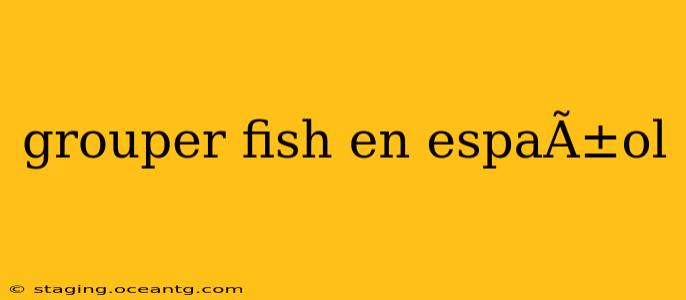The grouper, known as mero in Spanish, reigns supreme in many coral reef ecosystems. These impressive fish, belonging to the family Serranidae, are prized for their culinary value and captivating presence in the underwater world. This comprehensive guide delves into the fascinating world of meros, exploring their diverse species, habitats, culinary uses, and conservation status.
¿Cuántos tipos de meros hay? (How many types of groupers are there?)
The Serranidae family boasts an astounding diversity, encompassing over 160 species of grouper worldwide. The exact number varies depending on taxonomic classifications, with ongoing research continually refining our understanding. Some of the most well-known meros include:
- Mero Goliat (Goliath Grouper): This colossal species, Epinephelus itajara, is the largest grouper, reaching weights exceeding 800 pounds. Sadly, it's listed as endangered due to overfishing.
- Mero de Nassau (Nassau Grouper): Epinephelus striatus is known for its distinctive dark stripes and vital role in reef ecosystems. They are often targeted by fisheries, impacting their population numbers.
- Mero Cabrilla (Red Grouper): Epinephelus morio is a common species found in the Atlantic Ocean and often encountered by recreational divers.
- Mero Negro (Black Grouper): Mycteroperca bonaci boasts a dark coloration and is another popular target for fishing.
This list is far from exhaustive, with numerous other species exhibiting diverse sizes, colors, and habitat preferences. The specific meros found in a region depend on the local environment and oceanic currents.
¿Dónde viven los meros? (Where do groupers live?)
Groupers are primarily found in tropical and subtropical waters around the world. They inhabit a wide range of marine environments, showing a preference for:
- Coral reefs: These vibrant ecosystems provide ample food and shelter for many grouper species.
- Rocky reefs: Similar to coral reefs, rocky reefs offer hiding places and abundance of prey.
- Seagrass beds: These areas often serve as nurseries for juvenile groupers.
- Mangrove forests: Mangroves provide a crucial habitat for young groupers, offering protection from predators.
¿Cómo se pesca el mero? (How is grouper fished?)
Grouper fishing methods vary, ranging from:
- Recreational fishing: Many anglers target groupers for their sport and culinary value, often employing hook-and-line techniques.
- Commercial fishing: Commercial fisheries utilize various methods including traps, nets, and longlines, which can have significant impacts on grouper populations if not managed sustainably.
Sustainable fishing practices are essential to ensure the longevity of grouper populations.
¿Es el mero un pez comestible? (Is grouper an edible fish?)
Yes, grouper is highly valued as a food fish. Its firm, white flesh is prized for its delicate flavor and versatility in cooking. It's commonly prepared in various ways, including grilling, baking, frying, and stewing.
¿El mero está en peligro de extinción? (Is grouper endangered?)
The conservation status of groupers varies widely depending on the species. Some species, like the Goliath grouper, are critically endangered due to overfishing and habitat destruction. Others face varying degrees of threat, while some are relatively abundant. Sustainable fishing practices and habitat protection are crucial for the long-term survival of these magnificent fish. The IUCN Red List provides detailed assessments of the conservation status of individual grouper species.
¿Cuál es la diferencia entre un mero y un pargo? (What is the difference between a grouper and a snapper?)
While both groupers (meros) and snappers (pargos) are popular food fish, they belong to different families. Groupers are in the Serranidae family, characterized by their robust bodies and often large size. Snappers belong to the Lutjanidae family, generally having more slender bodies and a distinctive, pronounced jaw. Their appearance, habitat preferences, and even culinary properties can differ significantly.
This comprehensive overview of meros (groupers) in Spanish offers a deeper understanding of their biology, habitat, culinary significance, and the crucial importance of conservation efforts for their survival. Remember to always check local regulations regarding fishing and consuming grouper to ensure responsible and sustainable practices.
